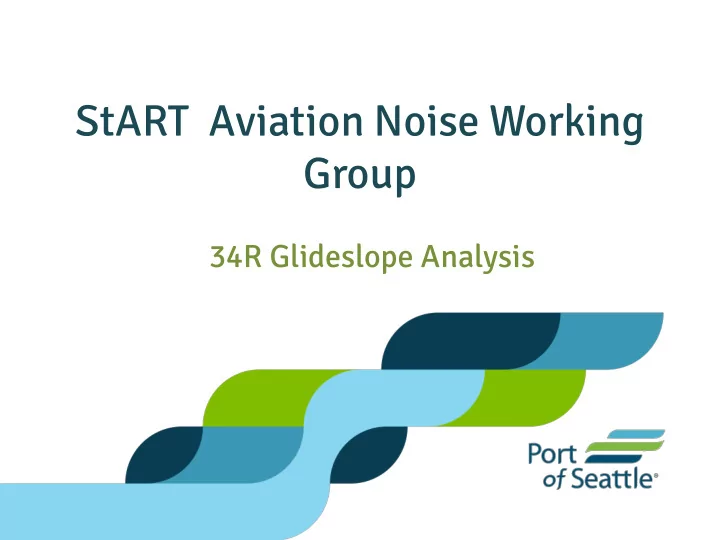

StART Aviation Noise Working Group 34R Glideslope Analysis
Agenda • Runway 34R Instrumentation • Instrument Landing System (ILS) • Area Navigation (RNAV) • Precision Approach Path Indicator • Alternatives • Recommendation • Questions 2
Instrument Landing System • Instrument Landings Systems are composed of two primary ground components – Localizer - provides horizontal information – Glideslope (GS) – provides vertical information • Primary Siting Standards: 3° glideslope angle & Maximum 60’ Threshold Crossing Height • Existing 34R ILS has 2.75° glideslope with 60’ threshold crossing height 3° GS is standard 3
ILS Glideslope Existing 34R ILS Approach Glideslope Antenna 60’ Threshold Crossing Height 34R GS is currently at maximum threshold crossing height 4
ILS Glideslope Relocated 34R Glideslope Antenna Relocated Glideslope Antenna 60’ Max Threshold Crossing Height 34R Antenna shifts towards runway end Relocation of GS Antenna needed to increase GS angel 5
Area Navigation (RNAV) • RNAV approaches are satellite based and do not relay on a navigational aids located at each runway end – Two RNAV procedures are currently published for Runway 34R (1) Required Navigational Performance (RNP) and (2) Global Positioning System (GPS) – Both RNAV procedures have glidepaths of 2.75° and 60’ threshold crossing heights 34R RNAV Approaches set to 2.75° GS 6
Precision Approach Path Indicator (PAPI) • Precision Approach Path Indicator is a lighting system that provides the pilot with glidepath information – 34R PAPI is set to 2.75° – Relocation of system needed to achieve 3° High Slightly High On Glidepath Slightly Low Low 34R PAPI Set to 2.75° GS 7
34R Glideslope Adjustment Alt. 1 1. Relocate glideslope antenna and PAPI to permanent location a) Relocate as part of a future project that impacts the glideslope (34R GS equipment moves to west side of runway) b) Adjust RNAV procedures after equipment is relocated Alternative 1 8
34R Glideslope Adjustment Alt. 2 2. Relocate glideslope antenna and PAPI a) Temporarily Relocate glideslope antenna on east side of Runway (Permanent relocation to follow) b) Relocate PAPI to permanent location c) Adjust RNAV procedures after equipment is relocated Alternative 2 9
34R Glideslope Adjustment Alt. 3 3. Temporarily adjust satellite based procedures only (RNAV/GLS) a) Adjust glideslope antenna and PAPI to final location when able NOTE: For safety, charting, and waypoint concerns it is highly encouraged that all approaches to a given runway end maintain the same glideslope. FAA support is needed to understand the validity of this alternative. Alternative 3 10
Glideslope Angle Comparison 1NM 2NM 3NM 4NM 5NM 6NM 7NM 8NM 2.75° 291' 583' 875' 1,167' 1,459' 1,751' 2,042' 2,334' 3° 318' 636' 955' 1,273' 1,592' 1,910' 2,229' 2,547' 3.1° 329' 658' 987' 1,316' 1,645' 1,974' 2,303' 2,632' 3.2° 339' 679' 1,019' 1,358' 1,698' 2,038' 2,377' 2,717' - All heights are approximate - All heights are above runway Threshold elevation (347’ MSL) 11
Alternatives Matrix Glideslope Angle Alternative 3° 3.1° 3.2° Alt. 1 - Relocate GS equipment to permanent location Alt. 2 - Temporarily relocate GS equipment Alt. 3 - Temporarily adjust satellite based procedures only 12
Case Study Approaches in the United States with greater than 3° glideslope • CAT II – Cleveland: RWY 6R CAT II SA with 3.1° GS – Newark: RWY 4L CAT I/II SA with 3.1° GS • CAT III – Of the 128 CAT III approach in the National Airspace System no approach is greater than 3° – Only 2 CAT III approaches are less then 3° Limited cases in U.S. of greater than 3° GS 13
Alternatives Matrix Glideslope Angle Alternative 2.95° 3° 3.1° 3.2° Alt. 1 - Relocate GS equipment to permanent location Alt. 2 - Temporarily relocate GS equipment Alt. 3 - Temporarily adjust satellite based procedures only Alternatives with highest likelihood of running into issues during procedure development and have the lowest likelihood of success 14
Alt. Comparison Matrix Procedure Operational Time To Alternative Total Cost Development Impact Implement Priority May take longer then Alt Medium Priority Alt. 1 - Relocate GS 2 but options available to No Impact (leverage SAMP equipment to Base Cost condense schedule may clean switch over efficiency benefit to gain result in similar time to permanent location higher priority) implement Base Cost + Temp Relocation Alt. 2 - Temporarily (Insufficient time to ILS taken out of service Quickest time to Lowest Level Priority capitalize temp during temp relocation adjusted GS angle (Noise) relocate GS equipment relocation) Alt. 3 - Temporarily No Construction, Lowest Level Priority adjust satellite based Base Cost No Impact Procedure Development (Noise) Only procedures only 15
Working Group Recommendation • Alternative 1 - Relocate GS equipment to permanent location • Attempt to obtain a 3.1° glideslope angle • Look for means to expedite the project – Begin Design (Design at Risk) – Initiate procedure development as soon as possible Alternative 1 at 3.1° Glideslope Angle 16
Questions 17
Glideslope PAPI Antenna Runway Threshold Existing Conditions 18
Recommend
More recommend